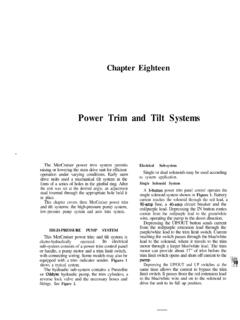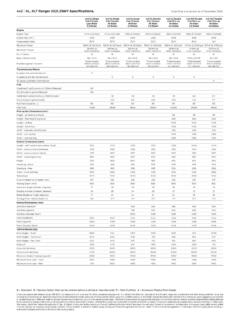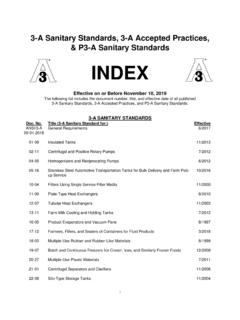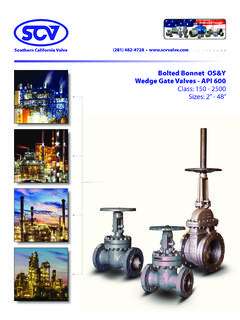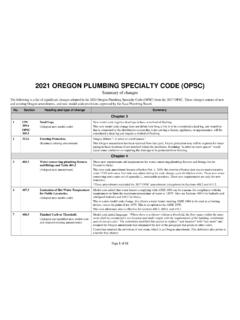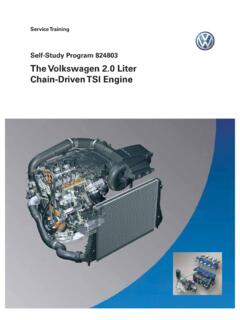Transcription of GM Inline Engines
1 Chapter Six GM Inline Engines This chapter covers the GM 153 and 181 cid The oil pump is located on the bottom front of 4-cylinder Engines and the GM 194, 230, 250 and the block on the starboard side and is driven by the 292 cid 6-cylinder Inline Engines used on distributor shaft. The distributor is driven by a gear MerCruiser 110 through 200 models. Although on the camshaft. differing in displacement, these Engines are Specifications (Table 1 and Table 2) and essentially the same design with many tightening torques (Table 3) are at the end of the interchangeable parts. chapter. These Engines are used with the following MerCruiser models: a. Model 110, 120, 120R and 120MR-153 cid. b. Model 140-181 and 194 cid. ENGINE SERIAL NUMBER. c. Model 140R and 140MR- 181 cid. The engine serial number is stamped on a plate d. Model 150-230 cid. mounted on the right rear side of the engine block.
2 E. Model 160 and 165-250 cid. above the starter motor (Figure 1). f. Model 200-292 cid. This information identifies the engine and The cylinders are numbered from front to rear: indicates if there are unique parts or if internal l-2-3-4 (6cylinder) and l-2-3-4-5-6 (6-cylinder). changes have been made during the model run. It is Engine firing order is also standard: l-3-4-2 important when ordering replacement parts for the (Ccylinder) and l-5-3-6-2-4 (6-cylinder). engine. Rocker arms are retained on individual threaded studs. A ball pivot valve train is used, with camshaft motion transferred through the hydraulic SPECIAL TOOLS. lifters to the rocker arms by pushrods. The 4-cylinder crankshaft may be supported by 4 Where special tools are required or or 5 main bearings; the 6-cylinder crankshaft has 7 recommended for GM engine overhaul, the tool main bearings.
3 The rear bearing on each takes the numbers are provided. Mercury Marine tool part end thrust. Crankshaft rotation is counterclockwise numbers have a C prefix. GM tool part numbers when seen from the drive unit end of the engine. have a J prefix. While GM tools can sometimes The gear-driven camshaft is supported by 4 be rented from rental dealers, they can be bearings and is located above the crankshaft in the purchased from Kent-Moore, Inc., 28635 Mound engine block. Road, Warren, MI 48089. GM Inline Engines 105. REPLACEMENT PARTS manufactured to Mercury's specifications. Any Various changes are made to automotive engine damage resulting from the use of other than blocks used for marine applications. Numerous Quicksilver parts is not covered by the Mercury part changes are required due to operation in fresh Marine warranty. and salt water.
4 For example, the cylinder head gasket must be corrosion-resistant. Marine Engines ENGINE REMOVAL. use head gaskets of copper' or stainless steel instead Some service procedures can be performed with of the standard steel used in automotive the engine in the boat; others require removal. The applications. Brass expansion or core plugs must be boat design and service procedure to be performed used instead of the steel plugs found in automotive will determine whether the engine must be blocks. removed. In some installations, it may be Since marine Engines are run at or near necessary to remove the stern drive unit first. See maximum rpm most of the time, the use of special Chapter Fourteen. valve lifters, springs, pistons, bearings, camshafts and other heavy-duty moving components is necessary for maximum life and performance. WARNING. The engine is heavy, awkward to handle and has For these reasons, automotive-type parts should sharp edges.
5 It may shift or drop suddenly during not be substituted for marine components. In removal. To prevent serious injury, always addition, Mercury recommends that only observe the following precautions. Quicksilver parts be used. Parts offered by other 1. Never place any part of your body where a manufacturers may look alike, but may not be moving or falling engine may trap, cut or crush you. 2. If you must push the engine during removal, 01. use a board or similar tool to keep your hands SERIAL NO. LOCATION out of danger. 3. Be sure the hoist is designed to lift Engines and has enough load capacity for your engine. 4. Be sure the hoist is securely attached to safe lifting points on the engine, 5 . The engine should not be dtJicult to lift with a proper hoist. If it is, stop lifting, lower the engine back onto its mounts and make sure the engine has been completely separated from the boat.
6 1. Remove the engine hood cover and all panels that interfere with engine removal. Place to one side out of the way. 2. Disconnect the negative battery cable, then the positive battery cable. As a precaution, remove the battery from the boat. 3. Disconnect the throttle cable at the carburetor (Figure 2). If necessary, remove cable from anchor plate. 4. Disconnect the engine-to-instrument panel wiring harness. 5. Disconnect the fuel lines at the fuel pump (Figure 3). Plug the fuel lines to prevent leakage. 6. Disconnect the brown and black (shift interlock). wires from the shift plate terminal block. 7. Disconnect the red and black power trim pump motor wires at the engine. 8. Disconnect the trim indicator sender wires (if so equipped). 106 CHAPTER SIX. 9. Disconnect the water inlet hose. Open the engine drain valve(s) and drain all water from the block.
7 10. Disconnect the exhaust elbow bellows. 11. Disconnect the drive unit shift cable from the J-clamp on the flywheel housing. 12. Disconnect the intake manifold vacuum hose, if so equipped. 13. Disconnect any accessories connected to the engine that will interfere with removal. 14. Attach a lifting bracket to the engine lifting eyes. Connect the bracket to an engine hoist and elevate it enough to remove all slack. NOTE ENGINE MOUNTING. At this point, there should be no hoses, wires or BRACKET PARTS. linkage connecting the engine to the boat or :: stern drive unit. Recheck this to make sure I II. nothing will hamper engine removal. - Special split 15. Remove the front and rear engine mounting bolts. 16. Slide the engine forward sufficiently to disengage it from the drive shaft assembly. 7$ lockwasher ALarge fiber washer /. 17. Remove the engine from the boat with the hoist.
8 ENGINE INSTALLATION. Engine installation is the reverse of removal, plus the following. 1. Coat the engine coupling splines with Universal Joint Lubricant (part No. C-92-74058). 2. It may be necessary to rotate the crankshaft slightly to align the engine coupling splines with the drive shaft. You may also rotate the drive shaft by placing the outdrive in forward gear and rotating I. the propeller. Mount bolt t 3. Install the front engine mount bracket. Steel washer . 4. Position a large fiber washer on top of the inner Spacer transom plate mounting brackets. Position the - \I. special split lockwasher inside the fiber washer. See Figure 4. 5. Position engine over the transom plate mounting brackets. Install hose clamps over the rubber exhaust elbow bellows, then fit bellows over .. the exhaust manifold outlet and tighten the clamps I mina; usr *UBE II.
9 Securely. See Figure 5. CA UTION 6. Install steel washers and spacers on the Elastic stop nuts should never be used more than mounting bolts, then insert bolts down through the twice. It is a good idea to replace such nuts with rear engine mounts, washers and mounting new ones each time they are removed. Never use brackets. See Figure 5. Install elastic stop nuts on worn-out stop nuts or non-locking nuts. bolts and tighten to specifications (Table 3). GM Inline Engines 107. engine with the hoist as required to permit indexing with no resistance. 9. Tighten all fasteners to specifications (Table 3). Remove the alignment tool. 10. Refer to Figure 7 and connect the throttle cable as follows: a. Move remote control to neutral gear, idle position. b. Connect cable end guide to throttle lever with flat washer and nut. c. Holding throttle cable behind the brass barrel, push it toward the throttle lever.
10 Adjust barrel to align with anchor stud, then connect barrel to stud with flat washer and nut. d. Make sure throttle valves are wide open when remote control is in full-forward position, then turn wide-open throttle stop adjusting screw clockwise until it just touches the THROTTLE CABLE throttle lever. e. Tighten set nut securely, return control to neutral gear, idle position and make sure that idle stop screw rests against the stop. 11. Fill the engine with an oil recommended in Chapter Four. 12. Fill the cooling system, if equipped with a closed system. See Chapter Twelve. 13. Adjust the drive belts. See Chapter Thirteen. Wide open throttle DISASSEMBLY CHECKLIST. stop adjusting screw To use the checklists, remove and inspect each part in the order mentioned. To reassemble, go Brass barrel through the checklists backwards, installing the parts in order.

